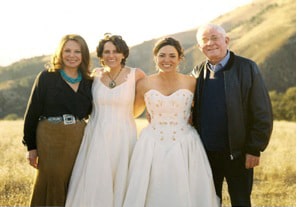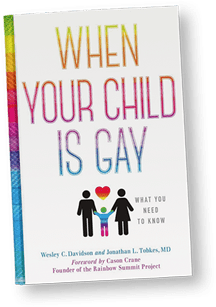 |
| Marlo Thomas and Phil Donahue share a happy moment with Marlo’s niece Tracy (left) and her new spouse Tracey. |
Dilemma: You’re invited to a same-sex marriage. What do you call the two brides?
a. companions (sounds as if they are in their “twilight” years)
b. partners (remind you of a stuffy “white-shoe” law firm?)
c. lovers (rings of pre-legal “tying the knot”)
d. husband and husband and wife and wife (which one is the wife?)
These and other complexities of living “out” loud in today’s diverse society: from the workplace, baby showers for same-sex couples, (who’s the father?) travelling to gay-friendly places as well as visiting straight parents with recent lovers are all addressed by “Mr. Manners,” Steven Petrow in his new book (cowritten with Sally Chew) Steven Petrow’s Complete Gay & Lesbian Manners: The Definitive Guide to LGBT Life (Workman Publishing, 2011).
Steven writes “Queeries,” a nationally syndicated column, and a respected website called Gay Manners. He also writes about manners for The Huffington Post, The Advocate, and 365 gay.com. He authored When Someone You Know Has AIDS (1993) and The Essential Book of Gay Manners and Etiquette (1995).
Co-author Sally Chew is a former editor at Time Inc.’s Health.com as well as gay magazines such as Vibe, Out, and Poz. Ms. Chew is the author of A Fatal Lie: A True Story of Betrayal and Murder In The New South (1999).
Their book is divided into Five Parts: Part I: “Being Gay,” Part II: “Love and Sex,” Part III: “Tying the Knot,” Part IV: “Children,” Part V: “Everyday Life.” This etiquette book, more than 395 pages, is written in a lively tone with a humorous bent and includes advice on how to introduce your partner to your workplace, as well as hundreds of other questions that are raised for not only GLBT readers, but also a straight audience.
How to Address a Couple
I wouldn’t know how to address invitations to lesbian and gay couples, for example, if I had not read the section entitled “The Art of Connecting.” When LGBT couples are committed (legally or not), their names should be placed on the same line and joined by the word “and” to signify their union.
While this is an etiquette book, I found some of the advice superfluous: for example, folding a napkin for a dinner party is the same for a gay person as for a straight one. I think information like this is wasted on an audience who would be more interested in narrowing the gap between the two groups and is the raison d’êtrefor this book.
Exploring Financial and Legal Considerations
What I found more interesting were the non-etiquette points Petrow raises which are only germane to the GLBT audience such as the extra financial and legal considerations LGBT must consider when owning property such as applying for health insurance for their loved ones, divorcing in states where gay marriages can not take place, marrying non-U.S. citizens and the deprivation of more than a thousand benefits that straight couples enjoy but GLBT couples cannot due to federal laws.
There are two particularly good sections explaining the differences among civil unions, domestic partnerships, and commitment ceremonies. The subtle nuances always baffle the general public. The authors stress the need for estate planning with a GLBT-savvy lawyer so your biological kin won’t necessarily inherit your property if you outlive your lover.
The chapters on starting a family are excellent, from getting pregnant via sperm donation, to 2nd party adoptions, to the importance of gay-friendly neighborhoods, and ways to insure acceptance at schools for children of gay couples.
With few role models, gays, as well as straights, need answers so they can relate well to each other, and not offend one another due to naïveté. Petrow’s and Chew’s Complete Gay and Lesbian Manners is a major step in this direction.

When Your Child Is Gay: What You Need To Know
For more detailed advice, see book, co-authored with a mother of a gay son and a psychiatrist, Jonathan L. Tobkes, M.D.